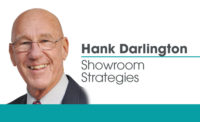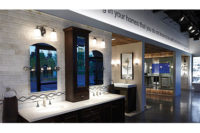America's first DPH showroom

Union Hardware’s David Goldberg, pictured on the famed Loo-cy toilet, has taken the decorative plumbing and hardware distributor in a new and successful direction, focusing on high-end European products. Photo courtesy of David Goldberg.

Union Hardware, which now features one location in Bethesda, Md., was started in the 1960s by David Goldberg’s father, Charlie Goldberg, who is believed to be the first to open a decorative plumbing and hardware showroom. Photo courtesy of David Goldberg.

The move to specialization has helped Union maintain gross-profit margins of 46%. Photo courtesy of David Goldberg.

David Goldberg created this Van Gogh “Starry Night” artwork from door and cabinet hardware pieces.




I have been blessed to have had three separate careers. Several years as a “professional manager” in the wholesale segment, then 17 years of owning one of the first “one-stop shopping” bath-and-kitchen showrooms in America and finally as a consultant, writer, speaker and teacher on all things related to DPH showrooms. I’ve loved every bit of it!
Recently I was reflecting on why I’ve had this “love affair” with the showroom segment. The answer is easy: it’s the people I’ve met and worked with along the way. Our employees, some incredible vendors, great manufacturers reps, other showroom people and, of course, many of our customers contributed to this love affair. Many of these folks continue to be great friends. One special person who touched my life in a unique way was Charlie Goldberg, who owned and operated what I believe was the very first DPH showroom business in America, Union Hardware, now headquartered in Bethesda, Md. Charlie died eight years ago and his son, David, currently is running the business.
I met Charlie at an Artistic Brass Advisory Council meeting in 1985. There were eight owners of independently operated showrooms at the meeting. All were pioneers in the decorative plumbing and hardware showroom business. From this meeting the idea of doing a national trade organization was born. Today’s Decorative Plumbing and Hardware Association with 300-plus members is the result of that meeting.
Back in the mid-1980s there were really only four decorative faucet manufacturers. The aforementioned Artistic Brass, Broadway Collection, Phylrich and Sheryl Wagner. Of these, only Phylrich and Sheryl Wagner still are in business. I could ramble on for many more pages about the history of the DPH industry, but we’ll save that for another time.
How it started
In 1914, Charlie’s father, Abraham, had asked the hardware store he was working at for a one-cent raise (yep, that’s one cent). He was turned down! Being headstrong and an entrepreneur at heart, he left that business and started Union Hardware in Washington, D.C. The business thrived selling traditional hardware products. My good friend Charlie went to work with his dad in 1954. As a note of historical interest, Abraham’s personal home sat where today’s Library of Congress is located (Even back then, the government could acquire property via eminent domain).
In the early 1960s, Charlie bought a small display of decorative cabinet knobs and pulls from Period Brass, and the idea of showing and selling decorative plumbing and hardware was born. These early decorative products were the first to emphasize design over function.
Charlie opened a separate store featuring only decorative products. Since there weren’t any decorative faucet manufacturers in the United States when he got this brainstorm, Charlie started making his own faucets. He made the spouts in the back of the store and bought handles from Spain. In the early 1970s, both Period Brass and Artistic Brass expanded into decorative plumbing products and Union Hardware was able to get out of the manufacturing business.
Charlie was truly the George Washington of the DPH industry. He helped the early manufacturers design products and, of course, was the first to show and sell them. When Carol and I started our showroom business in the early 1980s Charlie was a mentor, friend and inspiration to us.
Today’s Union
Charlie’s sons, David and Barry, joined their dad at Union Hardware in the 1980s. Since then, Barry has left the business to become a pilot and manager of a local airport so David is now at the helm.
The Union Hardware business model has changed dramatically in recent years. The old model was to show and sell a wide variety of decorative plumbing and hardware products. In the early years many of the decorative vendors would honor exclusive — or at least semi-exclusive — distribution. They expanded to four locations and were the “go-to” store for the higher-end decorative products in the greater Washington area.
Due to the advent of the internet, the 2006-2008 recession and the over-proliferation of decorative products, David Goldberg made the decision to go in an entirely different direction. I asked him why he did this.
“Today’s market is very different than it was just 15 years ago,” he says. “We’ve learned we couldn’t be all things to all people. Like doctors and lawyers, we believed it should be about specializing. We have been squeezed out of the “commodities” market because we refuse to lower our margins. Because of this, we started to deemphasize or discontinue major lines that were once our strongest products. We stopped going to U.S. trade shows because all we would find there were the same products that were being sold to everyone else. We replaced these trade shows with European trade shows.”
David told me since Europeans live in their homes for generations vs. an average of seven years in the United States, Europeans are willing to invest more in nicer products.
“We are also fortunate to be inside the Beltway of a very affluent city with a population that has traveled abroad where they see some very nice and unique plumbing products,” he adds. “Our area has gone contemporary in design and that works very well for us. We work with our clients to help them find products they will not only love, but will also cherish. This creates a strong emotional connection to the stories and people behind the products and rooms that we show and sell in our showroom.”
David notes the Washington, D.C., area is one of the top online purchasing cities in the U.S. “We didn’t like hiding manufacturer names and numbers and didn’t like worrying about our clients using their smartphones to ‘showroom’ us,” he says. “We learned great service alone wouldn’t always win a sale. In the end, we believe it’s about the products. They are the tools we work with and we want the best tools available.”
David also spoke specifically of Italian products. “It’s hard to beat Italian design,” he says. “With the Italians it more than just the design of a product, it’s about creating special spaces in unexpected ways or even proportions — mixing contemporary with formal, creating functional art as the goal vs. simply selling a sink and toilet.
“An example of this concept that we have on display in our showroom are glass vanities with back-to-back painted glass to form their structure. We also have ceiling-mounted waterfalls that are more like art and have inspired names such as ‘Virgin’ and ‘Nude.’ Then there is technology that offers push-button showers, both electronic and mechanical, mirrors with built-in scale readouts for weighing yourself and endless other features.”
David shares that the goal is to be on the leading edge of all these new trends but it wouldn’t be practical for many showroom businesses to either handle, take the risks or try to send mixed messages on why they exist.
Carol and I recently had the pleasure of visiting Union Hardware and experiencing David’s new business model. I agree with him that it wouldn’t work for the majority of DPH showroom businesses out there. Most likely, only the very large and more affluent cities could make this business model work. My good friend, Jeff Burton, who recently sold his Bath and Beyond business in San Francisco, was able to make it work
very well.
Union has the most expensive faucet I’ve ever seen on display: a THG Baccarat red crystal lav faucet with a list price of $20,000. The average selling price for water closets is in the $900 range, but with some going up as high as $8,000. Tubs on display range from $4,000 to $15,000.
One of the most unique things about the business is the original art work being displayed on the outside wall of the building and inside the showroom. I would urge you to visit the website www.unionhardware.com/V6/Starry.shtml to see and learn about the 8’ x 12’ “picture” of Van Gogh’s Starry Night made entirely of discontinued decorative knobs and pulls. This is an original art piece David created. Then, of course, there is Loo-cy — a toilet mounted on a platform, driven by a motor steered by your feet that has won first prize in several different parades in the D.C. area. Visit this website to get a smile from this: https://business.facebook.com/Nowthisnews/videos/1366062003483920/. I’ve had the pleasure of “driving Loo-cy” up and down the sidewalk in front of the store! The PR these very different things has given them is priceless!
Everyone appears to be much happier after downsizing from four stores to one 5,000-sq.-ft. space and from 30 employees to eight. By downsizing so dramatically, sales revenues have decreased, but by holding true to being unique and different, the company has been able to maintain gross-profit margins of 46%. Compare that to your margin and maybe it would entice you to be a tad more selective in the products you show and sell. The company’s newest sales person has worked there for 15 years. David believes they have the best “team” they’ve ever had and they’re having the most fun.
I’m not sure how my dear friend, Charlie, would react to the drastic new direction his son has taken the business. But Charlie was the original pioneer of the decorative plumbing and hardware showroom business concept, and I expect he might approve of David’s moving in an all-new direction and being a pioneer in his
own right.
If you are ever in the Washington area, you owe it to yourself to visit this unique and interesting business. I’ll bet David would even let you take “Loo-cy” for a drive.
Good selling!
Looking for a reprint of this article?
From high-res PDFs to custom plaques, order your copy today!










